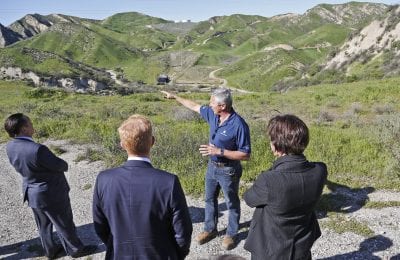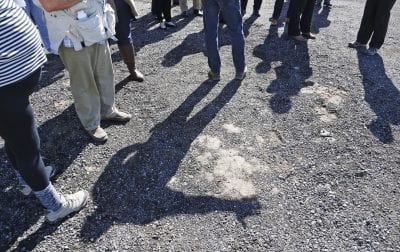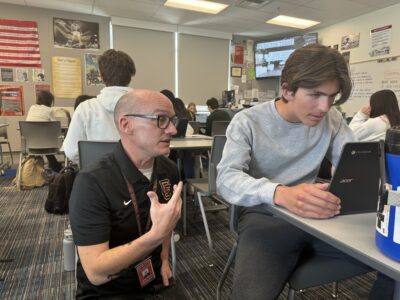Chiquita Canyon Landfill officials say they’re “downsizing” and that the landfill near Val Verde is shrinking, but in official documents filed with regional planners the officials have asked to increase the amount they dump and expand the amount of land they use.
Which is it? Is the landfill getting bigger or smaller?
After talking with regional planners and landfill officials Thursday, it was found that the landfill is expected to increase “laterally” in size by 143 acres on land Chiquita already owns, or to go from 257 acres to 400 acres.
The landfill is expected to be squashed in terms of reducing its highest ridge line of 1,700 feet of piled garbage which now looks lush and green, at the south end of its property, down to about “1,500 feet and change,” said John Musella, landfill spokesman.
Squashing would be something akin to using a trash compactor in your home.
The amount of garbage being dumped at the site is expected to remain the same, according to regional planner Richard Claghorn, as it relates to amounts comparable to what was dumped there in 2011.
Regional planners are expected to make a recommendation to the Regional Planning Commission which, in turn, will render a decision and then submit that decision to the Los Angeles County Board of Supervisors for final approval.
But what about the company’s talk Wednesday of downsizing the landfill?
Last year, the landfill took in 2.8 million tons of garbage – an unprecedented amount of trash.
Since regional planners have written a dumping cap of 2.1 million tons of garbage into the conditional use permit requested by landfill owners – mathematically, any trash dumped there in the future will be less than what was dumped there last year.
“The applicant (Chiquita Canyon Landfill LLC) has requested to change the amount of daily tonnage limit on their permit,” Claghorn told The Signal Thursday. “They’ve also asked to expand their acreage.”
This means, the request by landfill owners is to become bigger in size and for permission to dump more garbage than the amount spelled out in its current permit.
The current permit set by the county and signed in 1997 allows for 6,000 tons of trash to be dumped there in a day, on average, Musella said.
The company wants to dump double the amount of trash it dumps there now.
“What we’re asking from the county is permission for 12,000 tons a day,” Musella said Thursday.
Where will it go?
More land
The company is requesting permission from the county to dump trash on unused land it already owns at the site. Musella said he wants it made clear to the public that Chiquita is not expanding beyond the property it already owns.


Will more trash be dumped at the landfill than before?
If the planning commissioners follow the recommendation of their regional planners then – no.
“We are recommending that they stay at the level (of trash dumped at the site) they had in 2011,” Claghorn said.
Over the past two decades, trucks coming and going from the site on Highway 126, have been allowed to bring a maximum of 6,000 tons a day.
If commissioners approve the recommendation to planners, trucks will be allowed to dump a maximum of about 6,600 a day – not 12,000.
“We’re recommending they stay at the existing level, but they want to increase that level,” Claghorn said.
Downsizing?
“When they say ‘downsizing’ they’re looking at 2016 (numbers),” Claghorn told The Signal Thursday. “They had a total amount of trash there that year of 2.8 million. They want to use that as the comparison.
“That’s the reason they may consider it downsizing,” he said.
Did Chiquita exceed the amount of trash it was allowed to dump last year, which would have exposed the company to fines?
No, said Claghorn.


“They actually didn’t exceed the tonnage that was allowed by their permit,” he said Thursday. “Their permit allowed 30,000 tons per week of waste, which comes out to 1,560,000 tons of waste disposal.
“Their actual waste disposal tonnage amount was about 1.4 million tons in 2016, and their “beneficial use materials” were also about 1.4 million tons.
“The tonnage limit of the conditional use permit does not include beneficial use materials, and there is no existing cap for such material,” he said.
Not considered trash
When Chiquita officials took planning commissioners, reporters and citizens on a tour of the landfill Wednesday, they made a point of distinguishing garbage from reusable and recycled trash called “beneficial use materials.”
For example, crushed concrete delivered as trash to the site might end up being used to help create roads inside the landfill, and therefore stops being considered trash. Instead, it is considered a “beneficial use material.”
So, if a trash truck shows up with 3,000 tons of dinner plate scrapings and 3,000 tons of crushed concrete, only 3,000 tons of the refuse gets counted as trash.


Regional planners, however, are going to recommend that a cap be placed on how much “beneficial use material” can be used at the landfill in the course of a year.
“The amount of those (beneficial use) materials is tracked, but it is not considered part of the waste disposal tonnage and is a separate category,” Claghorn said.
“In the current recommended draft conditions, there is a cap on the amount of waste disposal of 1.4 million tons, and a limit of 700,000 tons of beneficial use, for a total of 2.1 million tons for all materials,” he said.
“However, it’s possible that the Commission could modify the draft conditions,” he added.
And, it’s on that possibility, Chiquita officials hope to get permission to dump more trash.
“It’s all up for discussion,” Musella said.
Chiquita plans to convince planning commissioners on this point between now and April 19 when the commission meets again.
661-287-5527
on Twitter @jamesarthurholt








